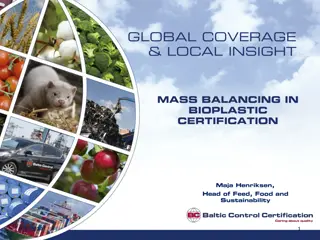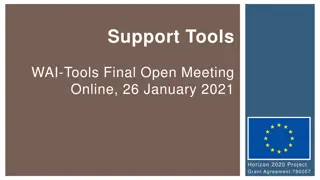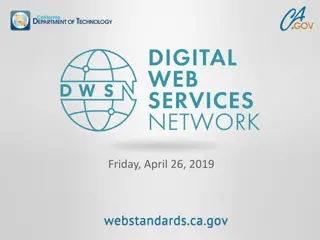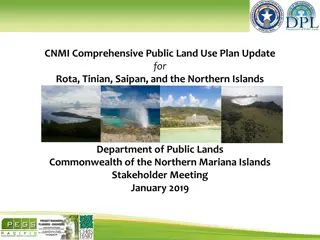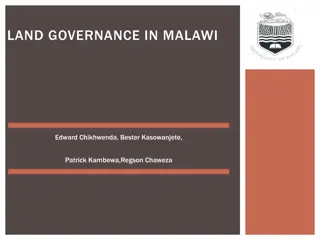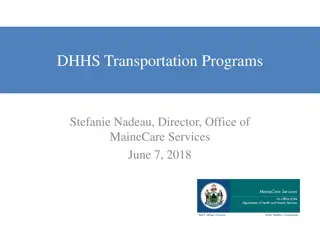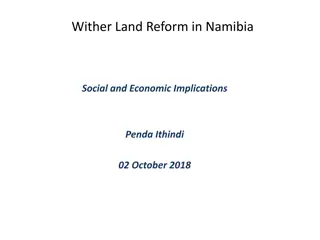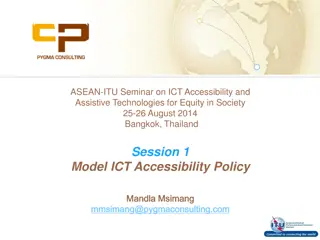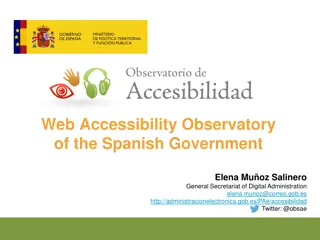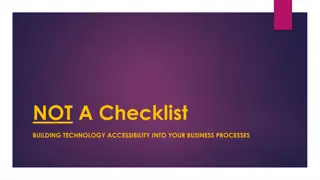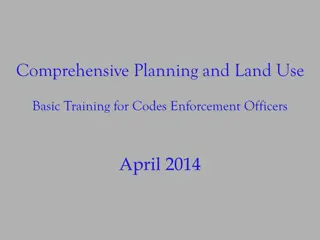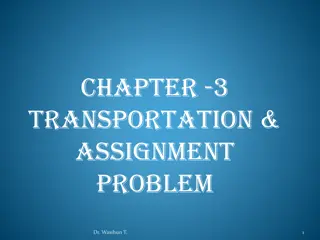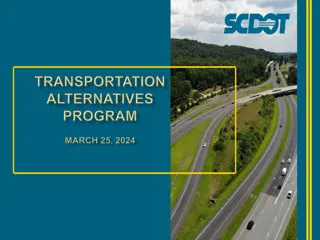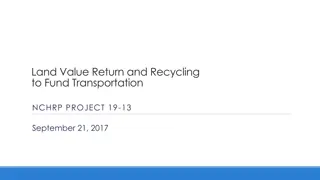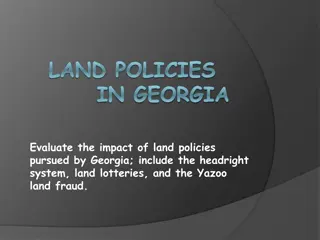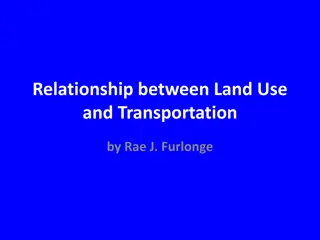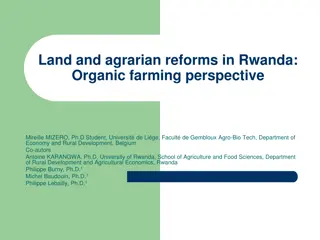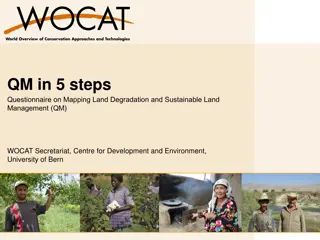Impact of Public Transportation and Land Use on Accessibility and Sustainability
Accessible transportation services contribute to the economic and social sustainability of cities by reducing travel times, waiting time, and the need for travel. The integration of public transportation with land use planning is essential for improving accessibility and sustainability in urban areas. Efforts towards sustainable public transportation systems must address issues of accessibility, economic growth, and spatial dispersion of activities.
Download Presentation

Please find below an Image/Link to download the presentation.
The content on the website is provided AS IS for your information and personal use only. It may not be sold, licensed, or shared on other websites without obtaining consent from the author.If you encounter any issues during the download, it is possible that the publisher has removed the file from their server.
You are allowed to download the files provided on this website for personal or commercial use, subject to the condition that they are used lawfully. All files are the property of their respective owners.
The content on the website is provided AS IS for your information and personal use only. It may not be sold, licensed, or shared on other websites without obtaining consent from the author.
E N D
Presentation Transcript
P U B L I C T R A N S P O R T AT I O N A N D L A N D P U B L I C T R A N S P O R T AT I O N A N D L A N D U S E I M P A C T S O N A C C E S S I B I L I T Y U S E I M P A C T S O N A C C E S S I B I L I T Y F O R S U S T A I N A B L E P U B L I C F O R S U S T A I N A B L E P U B L I C T R A N S P O R T AT I O N S Y S T E M I N T R A N S P O R T AT I O N S Y S T E M I N B L O E M F O N T E I N B L O E M F O N T E I N NDAKHONA BASHINGI Southern African Transportation Conference 12 July 2018
Accessible transportation services improves economic and social sustainability of the city. Reduced travel times, waiting time, number of trips and the need for travel could save money, save time and increase the ease of completing a journey. Transportation and mobility create accessibility to the services and activities located in different areas of a city, therefore should be prioritized with regards to land use zoning and development of cities. Sustainability of public transportation far from being achieved. Inaccessible urban systems in developing countries. Mass transit BRT High speed trains Advanced ICTs Transportation systems Land use, zoning
ACCESSIBILITY The ease of reaching destinations or completing a journey. Reduced travel times Increased ease of completing a journey Waiting time Lower number of trips Reduced or limited need for travel Is improving public transportation systems alone enough to address sustainability? Economic and social growth Spatial dispersion of activities Land use and zoning should compliment transportation systems
Land use and zoning are some of the important factors that contribute in achieving sustainable urban areas. The purpose of land use is to support people s lives, economic activities and protect the environment. Functional urban areas, land use and transportation should be complimentary to each other for economic and social growth as well as for the spatial dispersion of activities Growth of ICT solutions for transportation and travel problems should not prevent consideration of limitations of Information and communication Technology (ICT). ICT cannot reduce activity-travel due to growing car dependence in developing countries and most of the technologies are outside the financial reach of most developing countries
LITERATURE In the ICT era, accessibility can no longer be measured by time, distance and cost Golob, 2003 Accessibility could be measured by distance to stop, place of work, length of journey Cheng and Chen, 2015 Can only apply where e-activities have replaced the need to travel, therefore cannot be used in cases of cities where e- activities are inaccessible (Lila and Anjaneyulu, 2016).
Within zones of an urban area, different activities in which people need to travel to access are located and separated into various land uses. The main use of land use and transportation policies is to improve accessibility - (Wee, Geurs and Chorus, 2013), Public transportation services are essential for sustainability, liveability and equity of cities (Diab, Lierop and El-geneidy, 2017)
BRANDWAG STUDY AREA CBD WILLOWS The study evaluates accessibility of public transportation and ICT for selected suburbs of residence in the city and various activity-based locations, time and distance, ultimately evaluating land use and zoning in Bloemfontein. BATHO / SPORTS BOCHABELA 153 Respondents ROCKLANDS BLOEMANDA
RESEARCH QUESTIONS Is P/T and locations in BFN accessible Where are most essential services and activities located. Would ICT play a role in improving accessibility
DEMOGRAPHIC BACKGROUND Variable Age Group 18 - 25 25 35 Survey 44.4% 37.3% 36 - 45 13.1% 46 - 55 5.2% Gender Male Female 60.1% 39.9% Occupation Student Part-Time employee 38.6% 9.2% Self employed 5.9% Full-Time employee 30.1% Unemployed 6.5% Student + Part time employee 9.8% Personal income/month Mean Median R6764.38 R3000
PARAMETERS Distance Time Availability of direct public transportation. Number of trips per typical weekday or typical weekend day. Suburbs where respondents spend their normal work days and suburbs where they perform selected activities. ICT awareness and Internet access.
RESULTS WHAT HAPPENS WHERE? Residence Spend the day Direct Public transport 45.8 Yes 54.2 No
Shopping, banking, public services, education, religious , Banking Clubs Sporting activities Religious activities Educational activities Parks Stadium Clubs Public services Stadium Residential
TRIPS AND TRANSPORTATION TRIPS AND TRANSPORTATION Trips per day 80 69.7 66 70 60 50 Weekday Weekend 40 30.1 30 20 15.1 9.9 10 3.3 2 2 1.3 0.7 0 0 Trip 1 Trip 2 Trips 3 Trips 4 Trips Independent sample t-tests were carried out for the sample to find the relationship between availability of direct public transportation services or lack thereof and the number of trips taken by people per weekday or weekend day and results indicated that availability of direct transportation means lower number of trips.
PRIVATE AND NON-MOTORISED TRANSPORT ACTIVITY Shopping Work School Personal Leisure Sport Sightseeing Family obligations MODE Bus 2.6 4.6 2.0 2.0 1.3 2.0 1.3 7.2 Taxi 57.9 34.9 30.3 44.1 25.7 22.4 22.4 40.8 Cab 26.3 4.6 5.3 16.4 17.8 2.6 6.6 3.3 Private vehicle 15.8 9.2 8.6 18.4 15.8 11.2 11.8 23 Motorcycle 0.7 0.7 0.7 0.7 0.7 0.7 0.7 0.7 Bicycle 0.7 0 0 0 0.7 0 0 0 Walking 39.5 18.4 32.9 39.5 28.3 25.0 20.4 15.1 Low bicycle usage may be a result of lack of infrastructure such as bicycle lanes. Walking trips to school, shopping by people residing in the Willows, CBD, Westdene and Brandwag areas.
SPATIAL PARAMETERS & ICT RESIDENCE DAY SPENT Walking distance to bus stop (Km) Distance to work school Time spent travelling (Minutes) ICT Awareness Internet / Access (%) (%) (Km) BOCHABELA Willows, CBD, Westdene 0.2 - 1 2 - 10 10 - 45 100 89.5 WILLOWS Willows, CBD, Park West 0.1 - 1 0.5 - 6 5 - 30 78.6 92.9 ROCKLANDS CBD, Rocklands, Willows 0.1 - 2 5 - 25 20 - 45 72.7 90.9 BLOEMANDA CBD, Bloemanda, Willows 0.5 - 1 4 - 15 20 - 45 80 85 BRANDWAG CBD, Brandwag, Willows 0.2 - 2 4 - 6 15 - 30 86.7 86.7 SPORTS CBD, Westdene, Willows 0.2 0.8 4 - 10 10 - 30 88.2 94.1 WESTDENE CBD, Westdene 0.1 - 1 2 - 10 10 - 20 91.7 91.7
SPATIAL PARAMETERS ICT 41.8% of all respondents spend their day in willows, 24,2% in the CBD High levels of internet access and ICT awareness, but the people do not spend most of the day in their areas of residence, meaning lack of e-activities Areas where most individuals spend their day in are commercial and mixed land-use areas where educational institutions, retail outlets, banking and public services are located. These activities can however, be substituted through ICT, therefore reducing the need for travel. Most PT routes begin and end in the CBD, where taxi ranks and terminals are located. Those spending the day in Willows complete their journey by walking or taking another paid PT trip 6.5km average distance, 20min average time
CONCLUSIONS Sustainable PT systems still a challenge Poor spatial accessibility Limited NMT supporting infrastructure Inaccessible public transportation which lacks in mobility leaves captive demographics, specifically lower-income families that cannot afford private vehicle travel and young people without driving licences have no choice but to walk long distances and wait for very long times at bus terminals, stops and stations to access public transportation service. Independent operation of available modes bus and taxi to each its own limits accessibility and mobility Travel to perform activities is still prevalent due to lack of ICT alternatives to travel. There is limited choice in either opting not to travel based on ICT access or freedom to choose e-activities instead of travel.
The paper is derived from broader study on ICT for sustainable public transportation systems in Southern African cities with a greater focus on travel behavior, travel patterns and the role of ICT. THANK YOU


